Puzzles
To err is human but to puzzle is divine

Puzzles are a major spare time activity of mine. I only really started with this in 2002 by going to my first IPP (International Puzzle Party). To avoid confusion: the puzzles that I mean are things like you can see on the picture. Toys for grown-ups, things to fiddle around with, to try to take apart, get into a box, assemble into a cube or twist and turn until some colours match. Things you can spend hours with, trying to achieve the goal and that drive you near insanity and sometimes they just fall into place without any further thought.
My Design(s)
Please keep in mind that all puzzles presented here are copyrighted and may not be commercially reproduced without my agreement.
Choreographed Motion 2
 My exchange puzzle for IPP 41 in Houston. This is a successor for "Choreographed Motion". The puzzle is way harder than
the first. It takes 69 moves to completely assemble. Roughly halve of the moves are in some way "coordinated motion moves", e.g. they
require movement of at least 2 pieces in different directions.
Due to the more complex pieces the puzzle is quite a bit more chunky. Measuring 9cm by 9cm by 4cm and weighing about 215g. The pieces
slide really smoothly inside the frame. Overall I think it is a pleasure to play with, even if I think it is a bit too hard and intimidating a puzzle.
My exchange puzzle for IPP 41 in Houston. This is a successor for "Choreographed Motion". The puzzle is way harder than
the first. It takes 69 moves to completely assemble. Roughly halve of the moves are in some way "coordinated motion moves", e.g. they
require movement of at least 2 pieces in different directions.
Due to the more complex pieces the puzzle is quite a bit more chunky. Measuring 9cm by 9cm by 4cm and weighing about 215g. The pieces
slide really smoothly inside the frame. Overall I think it is a pleasure to play with, even if I think it is a bit too hard and intimidating a puzzle.
I made 125 for the IPP. I still have some left to be sold. They are 70 Euro a piece.
Diamond Snake
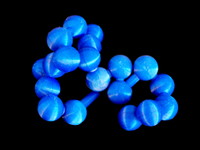 My exchange puzzle for IPP 38 in San Diego. The puzzle is similar to a cube snake. But insted of cubes with straight
through and 90 degree bends it has spheres with straight through, 45, 60, 90, 120 and 135 degree bends and with
two different distances between the spheres.
My exchange puzzle for IPP 38 in San Diego. The puzzle is similar to a cube snake. But insted of cubes with straight
through and 90 degree bends it has spheres with straight through, 45, 60, 90, 120 and 135 degree bends and with
two different distances between the spheres.
Your task is to build an octahedron.
The puzzle itself is not all that hard but it seems like a lot of people miss one possible way to fold the snake and always end up with a close to complete solutions but the last 2 spheres not fitting.
I made 100 for the IPP, 80 for the exchange and the remaining ones were sold. But I will print them on demand. Puzzle price is 15 Euro
4 Geometric Sculptures
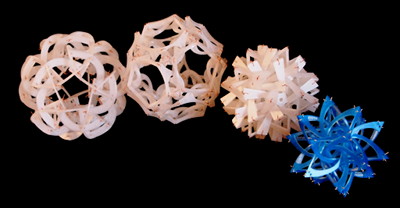 In the beginning of 2018 I got myself a 3d printer and after finishing the exchange puzzle I started playing
around. One of the fruitful projects was the re-creation of 4 geometric sculptures originally designed by
George Hart.
In the beginning of 2018 I got myself a 3d printer and after finishing the exchange puzzle I started playing
around. One of the fruitful projects was the re-creation of 4 geometric sculptures originally designed by
George Hart.
The 4 sculptures are Bouquet, Quintessence of Hedgehog, Celebration of Mind and Dodecahedron Sculpture
Non-Void Cube
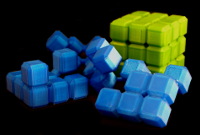 My exchange puzzle for IPP 37 in Paris. This puzzle is a cube of 3x3x3 little cubes. The 27 cublets are
distributed over 4 pieces. In the pieces some cubes are connected only via edge or corner connectors.
My exchange puzzle for IPP 37 in Paris. This puzzle is a cube of 3x3x3 little cubes. The 27 cublets are
distributed over 4 pieces. In the pieces some cubes are connected only via edge or corner connectors.
This kind of puzzle has been done before, but none of the cubes I know of has a level of 4. All hithero existing designs have a level of one, meaning the first piece can be taken out directly. While in my puzzle you need to shift the pieces around a bit before you can do that.
Usually it is impossible to have a solid object with a high level because you need some manoeuvering space to achieve that. This space is not available in a solid puzzle. Even the edge and corner connectors don't give you this space. But I came up with a slight addition that allowed me to design this cube.
The puzzle is quite easy. Some people have a bit of trouble with the last piece though.
110 were made in different colours blue, black, red, green and white.
I will continue to print them on my own 3d printer on demand with the colours available at that moment. Each puzzle costs 15 Euro.
Growing Triangle
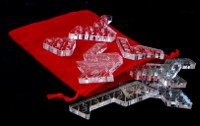 My exchange puzzle for IPP 35 in Ottawa. At the IPP in London I got a puzzle that I enjoyed very much. It is called
"London Squares" and was designed by Li Zhunyou. But in my eyes there are some flaws with the presentation. So I
designed a different version of this puzzle, using triangles instead of squares and set out to remove the
design flaws. I used thicker plastic to make it easier to pick up the pieces, I left out the tray as it is always
hard to get acrylic pieces back out of the tray. I included markers on the pieces to make it easier to count the
triangles on each piece.
My exchange puzzle for IPP 35 in Ottawa. At the IPP in London I got a puzzle that I enjoyed very much. It is called
"London Squares" and was designed by Li Zhunyou. But in my eyes there are some flaws with the presentation. So I
designed a different version of this puzzle, using triangles instead of squares and set out to remove the
design flaws. I used thicker plastic to make it easier to pick up the pieces, I left out the tray as it is always
hard to get acrylic pieces back out of the tray. I included markers on the pieces to make it easier to count the
triangles on each piece.
The result is "Growing Triangles". The puzzle consists of 12 pieces. Your task is to select a subset of these pieces and build a triangle. You start with 2 pieces and then with 3, 4... and so on all the way up to all 12 pieces. For each subset there is exactly one solution.
I've got some positive feedback on this puzzle. People like the slowly increasing difficulty for each bigger triangle. And even the biggest triangle is not impossibly hard to solve.
I've still got some puzzles left for sale. Each puzzle costs 15 Euro.
6✔ (Six Ticks)
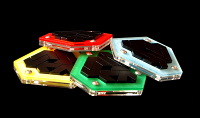 My exchange puzzle for IPP 34 in London. This year I wanted to make a simple and good looking puzzle.
Something you can put on the coffee table when you have a visitor. Something that can be solved while chatting
and that still gives you some kind of pleasure when solved. I also wanted it to be good looking and usable.
My exchange puzzle for IPP 34 in London. This year I wanted to make a simple and good looking puzzle.
Something you can put on the coffee table when you have a visitor. Something that can be solved while chatting
and that still gives you some kind of pleasure when solved. I also wanted it to be good looking and usable.
Many of the acrylic "put into tray" puzzles suffer from the problem that it is hard to get the pieces out of the tray once they are in. This puzzle doesn't.
The puzzle has 3 mirror pairs of pieces. They have a mark on one side to distinguish the two sides.
The tray has a coloured mark at the outer rim of the area where the pieces are supposed to be placed.
The task is to put all 6 pieces into the tray with the same face up (either all marks on top, or all marks on the bottom) so that the outer marked rim in the tray is completely covered. There are 2 different solutions.
It is relatively simple to find those 2 solutions but for even easier challenges you might want to relax the constraints:
- ignore the rim: 29 solutions
- additionally ignore the mark on the pieces: 1976 solutions
140 were made in 4 different colours (ice-blue, yellow, red, green). 100 were for the exchange. The remaining are available for selling 10 Euro per puzzle plus shipping (usually 3,45 Euro) plus paypal fee, if required.
Triade
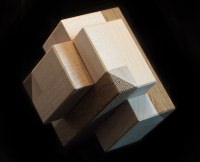 My exchange puzzle for IPP 32 in Washington. The puzzle consists of 3 pieces.
My exchange puzzle for IPP 32 in Washington. The puzzle consists of 3 pieces.
I tried to construct the pieces using the basic block and 2 added diagonally cut cubes. But sadly that allowed an invalid disassembly sequence that made the puzzle much easier. So I added some more cubes to one of the pieces, destroying the nice piece symmetry but getting a proper puzzle.
The puzzle has level 6 and one of the 6 moves is a coordinated motion move.
120 were made. 80 were for the exchange. The remaining are available for selling 20 Euro per puzzle plus shipping.
6-Piece Burr Variation
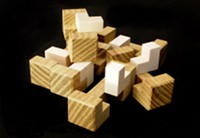 This has been my exchange puzzle for the IPP 31 in Berlin. It is my contribution to the realm of
6-piece burrs.
This has been my exchange puzzle for the IPP 31 in Berlin. It is my contribution to the realm of
6-piece burrs.
Each piece of the puzzle is made out of 2 units: a 6-piece burr shape. The one with the fewest cubes. If you look at this catalogue of 6-piece burr pieces it is piece 1023. The other unit is the L-tetromino.
There are 68 possible ways to connect those 2 units when you want to use the resulting shape in a normal 6-piece burr. Some of those shapes do have cubes outside of the 6x2x2 brick of the normal 6-piece burr shapes.
The 68 pieces can be assembled in 6213 ways into a 6-piece burr. 666 of those assemblies can be taken apart.
The highest level of all those solutions is level 6. There is only one set of pieces with a level 6 and this set is presented as this puzzle.
The puzzle is actually relatively simple. As is has only one assembly and that assembly can be found easily by finding some pieces that can go together only in one way.
So no need for a computer for this puzzle.
The pieces were made by the new Pelican workshop. The pieces are made out of 2 different woods so that you can actually see the 2 units they are made out of.
I still have a few puzzles left so if you are interested in having one, mail me. It's 17 Euro per puzzle plus shipping.
What Time Is It?
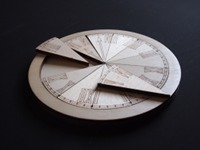 I designed this puzzle to be Andreas Schicks exchange puzzle at the IPP 31 in Berlin.
The puzzle consists of 12 pieces that do contain parts of the roman numerals for the 12
numbers on a clock face. The pieces do contain numbers on both sides. 2 Pieces do contain hands.
I designed this puzzle to be Andreas Schicks exchange puzzle at the IPP 31 in Berlin.
The puzzle consists of 12 pieces that do contain parts of the roman numerals for the 12
numbers on a clock face. The pieces do contain numbers on both sides. 2 Pieces do contain hands.
Your task is to assemble the pieces so that they form a proper clock face with all the required roman numerals. And then tell me "What time it is".
The pieces are designed in such a way that there are as many close solutions as possible. With "close solution" I mean a piece arrangement where all but one piece fits. The initial design has been a bit too hard so we included a little 'irregularity' that will give you a starting point.
The puzzle is made out of laser cut plywood. The cutting has been done by Peter Knoppers. Andreas sanded the pieces to make them look nicely.
All sold!
Choreographed Motion
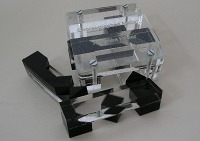 This is my exchange puzzle for the IPP 29 in San Francisco. Another coordinated motion puzzle designed with my
software. To assemble the puzzle you need at least 4 coordinated motion moves. They are all different some
requiring 3 some 4 pieces to be moved at the same time. Even a 4 piece move with all pieces in different directions
is required.
This is my exchange puzzle for the IPP 29 in San Francisco. Another coordinated motion puzzle designed with my
software. To assemble the puzzle you need at least 4 coordinated motion moves. They are all different some
requiring 3 some 4 pieces to be moved at the same time. Even a 4 piece move with all pieces in different directions
is required.
The puzzle was created by first starting a long running analysis of a complete set of simple pieces with triangles added in all kind of ways. That analysis was not completed but turned up a basic promising possibility. That design was then modified until a single solution with just 2 assemblies turned up.
The pieces were cut by Peter Knoppers. He also made gluing jigs. Then I glued the pieces. In case you wonder how it was done: I used Dichlormethane, which is a poisonous acrylic solvent. Put some drops onto the surface and quickly press the other piece on top. You need to be quick and precise because the solvent will visible vaporize within seconds and precise because spilled solvent on the clear acrylic will leave opaque stains which looks poorly. But if done right you will get a perfectly looking bubble free and very strong connection. You need to apply some pressure as otherwise air bubbles will form when the solvent vaporizes. The connection is strong enough for removal from the jig within a few minutes (I normally used 10 minutes setting time, but less is probably possible)
Well, enough of the technical stuff. I made around 140 puzzles, most of them for the exchange at the IPP. The puzzle itself is not very hard, but it is the first puzzle that I am aware of that requires multiple coordinated motion moves. CM 13 required 4 moves but all pieces were identical and the puzzle was symmetrical and there were only 2 different moves repeated twice. Here we have different pieces and 4 different moves.
All sold!
Loony Gear
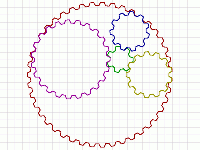 Well, this is not really a puzzle but rather a fun object.
Well, this is not really a puzzle but rather a fun object.
At the IPP 26 in Boston in 2006 Oscar van Deventer presented to me the idea of a epicyclic gearing where all planet gears have a different number of teeth. He explained to me all the constraints that need to be considered.
Once back home I started writing a little program that could do the necessary calculations for gears. It can handle proper touching circles and it can calculate if 2 gears properly mesh or if the teeth would overlap.
The program uses a monte carlo approach. It randomly selects the number of teeth for the gears and tries to place them. The positions are chosen so that the gears touch perfectly and then the meshing error is minimized.
It turned out that there were a lot of gears that had the required properties, so we started imposing further constraints like: It shall not fall apart (the planet gears must surround the sun gear). We wanted very small number of teeth. Finally we limited the number of teeth to prime numbers. This finally resulted in the loony gear that you can see on the picture. The gears have 7, 11, 13, 17 and 37 teeth.
If you click the image you will see it in action.
The only problem now is: what is it good for? If you have an idea please mail me.
CM13
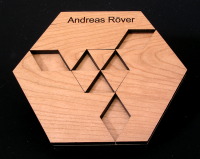 My exchange puzzle for the IPP 28 in Prag. As far as I know this is the worlds first multi-level
coordinated motion puzzle. The puzzle requires 4 moves to disassemble and all of them are coordinated
motion moves.
My exchange puzzle for the IPP 28 in Prag. As far as I know this is the worlds first multi-level
coordinated motion puzzle. The puzzle requires 4 moves to disassemble and all of them are coordinated
motion moves.
I designed the puzzle with BurrTools after I added the possibility to the program to analyze non-rectangular movements and coordinated motion moves in the triangle grid.
This puzzle has been the test case number 13. Some other test cases resulted in puzzles but all of them were only functional on screen and displayed unwanted properties as real live prototypes. For those interested: here is the BurrTools file. Keep in mind that the current public version of BurrTools can not analyze the puzzle it can only display the solution that is included within the file.
I brought 113 to the IPP some were made of Walnut some were Rosewood as on the picture. All of them are for the exchange.
All sold!
The Cube
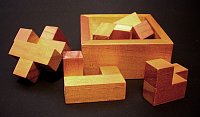 My exchange puzzle for the IPP 27 in Goldcoast Australia is a puzzle with 6 irregular pieces adding
up to 32 unit cubes. These 32 unit cubes fit in one way into the provided box (as a 4x4x2 brick). The
real task though is to make a cube using those pieces.
My exchange puzzle for the IPP 27 in Goldcoast Australia is a puzzle with 6 irregular pieces adding
up to 32 unit cubes. These 32 unit cubes fit in one way into the provided box (as a 4x4x2 brick). The
real task though is to make a cube using those pieces.
The curious can download a BurrTools file that contains the pieces and the solution for the box packing but not the solution for the cube problem.
Mr. Puzzle made the puzzle for me.
All sold!
Edges don't match?!
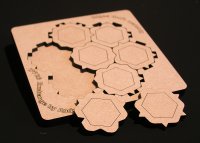 This was my exchange puzzle at the IPP 26 in Boston.
This was my exchange puzzle at the IPP 26 in Boston.
My brain has been working on this puzzle for quite a while. I can not speak here about the design process as this would give too many hints and spoil the fun.
Peter Knoppers has made 120 copies plus 2 for the design competition. All of them have been sold.
The puzzle is shipped in a transport solution with all pieces inside the tray, except that one piece is flipped over. Your task is now to get all pieces into the tray with the marked side up. As far as I know there is only one proper solution. In case you can not get all the pieces into the tray, I have engraved the transport solution on its reverse so you can always get all pieces in for storage.
In case this puzzle is eating up you brain I have prepared some hints. They give you up to 4 clues and the idea for the solution finally the solution itself.
All sold!
Uncoated Burr
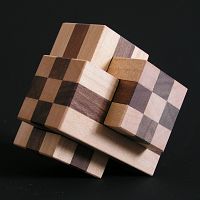 This has been my exchange Puzzle at the IPP 25 in Helsinky.
This has been my exchange Puzzle at the IPP 25 in Helsinky.
The shape was inspired by the "Coated Burr" designed by Jürgen von Känel. I always liked this shape and regretted that too few people are designing puzzles with this kind of symmetry. "Coated Burr" has 6 pieces where 3 pieces coat the other 3 pieces. As the pieces are not covered in my puzzle I decided to make my reference to the other puzzle and call it "Uncoated Burr"
The pieces were designed using the tools that I have programmed in the BurrTools package. I implemented a simple algorithm that starts with basic shapes and tries to add cubes to this shapes in such a way that the resulting puzzle is as complicated as possible.
The program needed be be restarted from time to time because it go stuck in local extreme points while trying to optimize. After many tries it got only a level 5 puzzle. I was near the point of saying: "OK, that's enough" but then I started on more try and this time the program generated a level 7 puzzle.
I have then manually changed that puzzle, trying to make it as simple to produce as possible. The resulting pieces and the solution can be found here. This file can be viewed with, of course, BurrTools.
The puzzle was made 140 times by Josef Pelikán.
It's not all that hard to assemble the puzzle, but if you really have problems you can always use BurrTools
All sold!